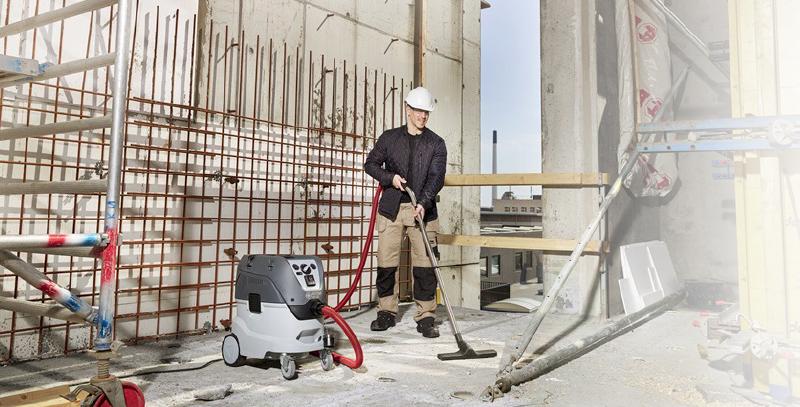When people think of construction sites, they do not think of the danger of construction dust. However, it is a very common cause of a range of respiratory diseases, reminds Nilfisk.
Construction dust can cause serious damage to your health and some types of dust can eventually kill you. Regularly breathing in these harmful dusts over a long period of time can cause life-threatening diseases to form on your lungs. The dangers of asbestos dust are well documented, while silicosis is an emerging health issue across the globe.
Every year, 5,000-6,000 people in New Zealand are hospitalised after being exposed to airborne contaminants at work. Workers in the construction sector are 20x more likely to die of exposure to harmful airborne substances than from a workplace accident.1
While there are regulations around exposure to asbestos and silica dust in the workplace, HEPA (High Efficiency Particulate Air) filter industrial vacuum cleaners are often preferred since they can completely collect and retain dust without dispersing it back into the environment. Methods like compressed air blow-downs and dry sweeping are discouraged since they create dust clouds and only transfer dust particulate from one area to another.
Nilfisk says it leads the industry in developing Industrial Vacuum Systems (IVS) to extract dusts that are hazardous to inhale such as Asbestos, Silica, Lead and Mould (Nilfisk VHS42 S2 and S3 H –Class).
The H-class certified vac range from Nilfisk allows the safe replacement of the absolute filter (bag-in, bag-out system) without getting in contact with the hazardous dust.
Nilfisk is also an industry leader in the development of IVS for combustible (explosive) dust that are IECEx and ATEX certified, designed to prevent the triggering of any source of ignition, making vacuum cleaning operations safe.
All asbestos vacuum cleaners must have a HEPA filtering system that is capable of trapping and retaining 99.97 percent of all mono-dispersed particles of 0.3 microns in diameter.
A HEPA filter is required for collecting most toxic and hazardous dusts.
The HEPA filtration for heavy industrial vacuums is 99.999 percent efficient, down to and including 0.3 microns. In Nilfisk industrial vacuum systems, the HEPA filter retains 99.97 percent down to and including 0.3 microns.
For applications that require even finer filtration, Nilfisk vacuums are available with an ULPA (Ultra Low Penetration Air) filter. It retains 99.999 percent of all particles, down to and including 0.12 microns. A HEPA filter is the final stage of filtration. Because of the hazardous nature of some of the materials collected by Nilfisk vacuums, each HEPA filter is individually DOP-tested to verify that it meets the proper specifications.
John Toolis, National Sales Manager for Nilfisk sums up why the highest standard design and manufacturer of the Nilfisk IVS range is so important, “At the end of the day, we want to see people go home to their family. Our primary concern is safety.”
Asbestos related illness
Worksafe NZ identifies asbestos exposure as the leading cause of death from workplace related disease. It is estimated the death toll from asbestos-related disease in New Zealand will continue to climb for decades to come, despite a ban on imports of building materials containing the toxic mineral.
The peak of asbestos-related disease in New Zealand will not be reached until sometime between 2030 and 2040. This is due to the long wait between exposure and disease – in some cases up to 55 years – and because the production of asbestos-containing building materials in New Zealand did not cease until 1987.2
Silica related diseases
Touted as the ‘new asbestos’, respirable crystalline silica is the leading cause of silicosis, the most common occupational lung disease in the world.
Silica, also known as silicon dioxide (SiO2), is naturally forming and can be found in well over 90 percent of the earth’s crust and almost 40 percent of all common minerals, making it a prevalent compound in any workplace environment where there is airborne dust. Crystalline silica is a form of silica.
Silica dust is created when materials containing silica are cut, ground, drilled or otherwise disturbed. If the silica particles in this dust are of a crystalline structure and are small enough (known as respirable crystalline silica or RCS), they can be breathed deep into the lungs and cause damage.
Silica is a natural substance found in concrete, bricks, rocks, stone, sand and clay. The dust that can be breathed in is not always visible to the naked eye.
Nilfisk, considered a leader in dust control, has a full line of vacuums well-equipped to help you safely collect silica dust and keep it away from your crew.
1 https://www.sitesafe.org.nz/guides--resources/Safety-Blog/dust/
2 http://www.nzherald.co.nz/nz/news/article.cfm?c_id=1&objectid=11658866
Details, Nilfisk New Zealand
0800 408 080.






